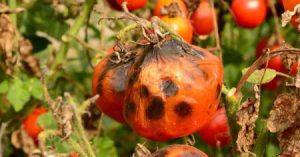Pocket Diagnostic® are the UK leaders in producing plant health rapid lateral flow tests which are unrivalled in terms of sensitivity and reliability. Several in-field test kits are available, and the one focusing on the rapid & early detection of Phytophthora is of great use to those involved in the propagation, growth and ongoing care of plants and trees.
Why? Quite simply, Phytophthora is the serial killer of the plant world.
What is Phytophthora?
Phytophthora (with a name derived from the Greek ‘plant destroyer’) species are microscopic, fungus-like organisms. After honey fungus, Phytophthora root rot is arguably the most common cause of root, fruit and stem-base decay of a wide range of trees, shrubs, plants and vegetable crops. The species causing root and stem-base decay are found within the soil, where they may survive for many years in the absence of a host plant. Phytophthora remains active throughout the year making it even more destructive.
There are over 200 Phytophthora species, all causing very similar symptoms. Potato seed, herbaceous perennials, bedding plants, soft fruits, pot plants and even bulbs can also be affected, in addition to woody shrubs and trees. It is also now one of the most devastating diseases of solanaceous and cucurbit crops, most notably of winter squash and peppers, and can cause total crop loss.
The organism attacks the root system and reduces the root area available for water and nutrient uptake and, therefore, above-ground symptoms often mimic water / environmental stress. If a plant has a poorly functioning root system – caused, for example, by Phytophthora – the nutrients needed to flourish are increasingly difficult for the affected plant to absorb.
A Spreading Decay
Phytophthora is spread in the ground by tiny spores that swim in the water films between soil particles. These spores can travel only very short distances (a few millimetres) under their own power, but chemicals exuding into the water films from the roots of a susceptible plant may attract the spores toward them. Phytophthora also produces long-lived resting spores that are released into the soil from the decaying roots. These can contaminate the soil in the vicinity of an affected plant for a considerable time, often several years.
A recent television news bulletin reported that around 8,000 trees – predominantly softwood species – had to be felled in the Forest of Dean due to Phytophthora ramorum, a highly destructive, algae-like organism called a water mould which causes extensive damage and death – known as ramorum disease – to more than 150 plant species, including some forest species. However, it is not only here that drastic measures have had to be taken to combat this disease.
Forestry England report that Phytophthora ramorum spores can also be spread over long distances, “via mists, air currents and watercourses. It can also be spread on footwear, dogs’ paws, tools, equipment, and vehicle wheels, including buggies and mountain bike wheels. Localised movement over short distances by wild animals such as deer and feral boar might also be possible.” Long-distance spread of Phytophthora may occur if the spores or soil containing them are carried in drainage or run-off water (e.g. down a slope). Movement of infested soil during cultivations or transplanting can also spread the problem. Bought-in plants carrying low levels of infection may introduce the disease into a garden.
What to Look Out For
Symptoms include wilting, yellow or sparse foliage and branch dieback. In many cases the symptoms get progressively worse until the plant dies. A common symptom in conifers is a gradual fading in the colour of the foliage, from a vibrant to a dull green, through to greyish and finally brown.
However, there are often no definitive above-ground signs of infection, particularly in the early stages, so taking samples for laboratory testing has been critical for detection and management. Laboratory testing can be expensive and time consuming though; but with Pocket Diagnostic® rapid lateral flow tests, diagnosis – and, therefore, immediate management decisions – can be made in-field, or whilst you prune your roses.
Critical Biosecurity Countermeasures
Knowing the dangers of Phytophthora, it is vital that we all are aware of some simple biosecurity measures that will help reduce the spread of Phytophthora and other plant pathogens. Visitors to woods, forests, parks and public gardens can help to minimise the spread by brushing soil, mud and leaf debris off footwear and wheels of bicycles, baby buggies and wheelchairs – before leaving the site. It is also recommended to wash these items at home before visiting another site.
There are additional more stringent biosecurity requirements for those who work in, or manage, woods and forests, such as foresters, forestry workers, tree surgeons and timber hauliers; and also those involved with large-scale crop production and horticultural activities. Sorbus International Ltd is the exclusive UK distributor of the Pocket Diagnostic® test range and they supply Biosecurity Kits and two approved disinfectants – Cleankill (water based) and Propellar (solvent based) – to clean boots, tools, etc., and remove oil / resinous sap. The Pocket Diagnostic® Phytophthora lateral flow tests can identify whether a particular site is infected or not. These tests can be purchased directly from Sorbus International, our exclusive UK distributor and as part of their Biosecurity Kits or directly from Pocket Diagnostics if located outside of the UK.
So, if your plants/trees are showing similar symptoms it is well worth checking that Phytophthora is or is not the cause. With a Pocket Diagnostic® lateral flow test kit, you’ll know in a matter of minutes and be able to mitigate the risks immediately.
